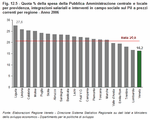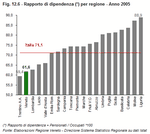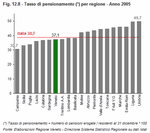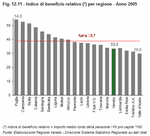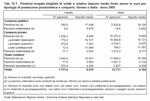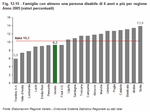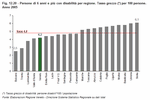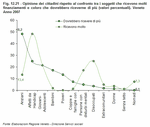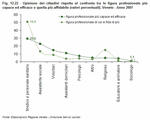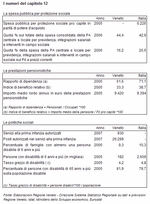|
12 - Welfare at the service of children, the disabled and the elderly Expenditure for social protection in Italy and Europe
The quality of solidarity systems for the weaker members of a society is certainly one of the parameters for evaluating the level of welfare and the quality of life of a country. Naturally these protective measures depend on public policies which are limited by stringent budget restraints. Nevertheless there is the attempt to respond to the many demographic and economic changes of recent decades in the best possible way. An adequate system of social protection works against poverty, attempts to reduce inequality in the distribution of income and is designed to redistribute resources among the various age groups of a nation. The great importance of policies for social protection in the societies of the twenty-first century is reflected in the high levels of expenditure dedicated to these policies by the European public administrations. The expenditure for social protection involves both the national insurance and the welfare systems. The former is connected to the world of work and operates on the basis of the relationship between the insurer and the insured and through financing made through the withholding of contributions, while the welfare services are directed to guarantee that citizens have adequate economic resources for subsistence. Expenditure for Italian social protection was 26.4% of the GDP in 2005, a percentage point lower than the percentage of GDP spent by the EU25: the trend for the Italian figure, however, is decidedly on the increase, with a growth of 6.9% from 2000 to 2005, compared to a growth of 3% in the European Union. Italian expenditure per capita until 2003 was greater than the per capita figure for the whole EU25, but in the following two years it was slightly less than the European average. (Figure 12.1) Nearly all the expenditure for social protection reaches the citizen in the form of social benefits, including monetary aid and aid in the form of goods and services: it is well-known that in Italy the former manner of providing support is traditionally the more commonly used. In Italy, even more than in Europe, the greatest share of social benefits are provided for old age and illness: these two items in Italy make up three quarters of the expenditure invested in social benefits for citizens in need. The share of spending dedicated to social benefits for survivors is rather high; while, in comparison to the European average, spending dedicated to the family, the disabled and the unemployed is lower. (Figure 12.2) Public expenditure for social protection in the Italian regions
The Italian social protection system consists of the insurance, the welfare and the health sectors; in this context only the first two components of spending for social protection will be examined in detail.In Italy the responsibility and purposes of welfare and insurance include, in addition to the administration of pensions, also services for income support, such as the subsidies for: unemployment, health, disabilities, maternity, family allowances. The recipients of social insurance benefits or welfare payments are therefore people who have retired from work, minors, people disabled by disease or invalidity, workers with inadequate income, the unemployed and people who need special forms of assistance to enter the workforce. The agencies which provide social benefits are the Economics and Finance Ministry, the National institute for social insurance (INPS), all the local administrations (regions, provinces and communes) and other institutions of public aid. Responsibility for the distribution of insurance benefits lies with the public insurance agencies, alongside other actors who manage private pension funds. The Public Administration in Veneto (Note 1) appropriated 44.4% of the total consolidated public expenditure (Note 2) in 2006 to the purposes of insurance and social assistance; about 43% is the analogous figure on the national level, on the increase over the last five years. (Figure 12.3) In per capita terms the spending appropriated to a citizen of Veneto on average amounted to 4.7 thousand euros, less than the national average of 5.1 thousand euros. In relation to the wealth produced, social insurance, income support and activity in the social field in Italy costs the central and local public administration 20,6% of GDP, whereas the value for Veneto is at only 16,2%, which puts it last among the regions. (Figure 12.4) and (Figure 12.5)
The main challenge related to expenditure for social protection, especially when it comes to the pension system, is the ageing of the population that has occurred in recent years: it has been generally accepted that it is necessary to increase investment in the current social insurance system in order to compensate for the high ratio between the elderly and the economically active population, who have to bear of the burden of the preceding generations.
A good ratio of dependency is the one found in Veneto in 2005, where 100 workers corresponded to 62 pensioners: the national figure is equal to 71 and the highest value was found in Liguria, where the index rises to 89, which makes the less imbalanced situations found in Trentino, in Veneto and in Lombardia stand out. The dependency ratio, however, probably underestimates the real burden on the population since it considers the ratio between pensioners and employees without considering the number of pensions received by each beneficiary. In Italy in fact in 2005 24.2% of pensioners receive 2 pensions, 6.1% receive 3 and indeed 1.3% 4 or more; 26.8% of which have accumulated different types of pensions (Note 3). (Figure 12.6) and (Figure 12.7) In confirmation of the reduced pressure on the population of Veneto we only have to look at the pension rate, that recorded 37.1 pensions paid per 100 inhabitants in 2005, a figure lower than the national average. This underlines the greater sustainability of Veneto's expenditures compared to many other Italian regions. (Figure 12.8) Pensioners in Veneto and their pensions
The highest rate of pension beneficiaries in 2005 is naturally found in the upper section of the age pyramid; however, nearly 34% of the recipients are less than 65 years old, an age normally identified as the threshold of old-age, at least when it comes to pensions. Female pensioners are slightly more numerous: women, characterised typically by greater longevity, continue to benefit from payment a longer time. The distribution of pensioners by age in fact records a large female presence in the over-seventy group, while in the younger age groups the majority of the pensioners are normally male. However men, even if they are 47.7% of the pensioners, receive the most of pension income, because of the larger average size of their benefit: men are more numerous in the groups with the higher monthly payments, while women are more common in those with lower payments. The average annual gross payment of pensions in Veneto is €12,390 for men, while for women the average is considerably lower, equal to €7,100. Besides the gender of the recipients, it is striking that many more pensioners are found in the categories with lower payments, a feature that underlines the need for greater investment for a better distribution of pension income. (Figure 12.9) and (Figure 12.10) The benefits related to the services provided to the citizens of Veneto is just over 33% of the regional GDP per capita, a figure which is lower than the national average of 39%. The fact that all the regions of the North register low figures for this area shows that the main reason for imbalance is the country's marked geographical difference when it comes to the production of wealth, rather than the difference in the average regional payments for services. (Figure 12.11) The differences in the regions' average payments can be explained also by the distribution of the kinds of pension paid. High pension levels in Italy are received by recipients of old-age pensions, while beneficiaries of indemnity and war pensions receive low average payments. The pension administration in Veneto tends to follow the trend in national distribution, however investing more in the fields of invalidity pensions, social pensions and war pensions: the average figure for these kinds of pensions are found to be greater than the national average, underlining the region's better response concerning invalidity and income support, areas for which support must absolutely be guaranteed. (Figure 12.12) In conclusion we will present a brief analysis of pension expenditure by the kind of work of the beneficiary, hereby only referring to the invalidity, old-age, survivors (Ivs) and indemnity pensions, as social assistance pensions, unconnected to the system of contributions, are paid without regard to the economic activity in which the beneficiary may have worked. In Italy 86.5% of the recipients of Ivs and indemnity pensions come from the private sector; in Veneto the rate is even higher, amounting to 87.7%. In line with what was said above, Ivs pensions are those with a higher average amount paid compared to other kinds of pension service, regarding both private and public employment. In 2005 in Italy the average gross annual amount of an Ivs pension was €10,790, while the average gross annual payment of indemnity and social pensions were decidedly lower, amounting to €4,132 and €4,308 respectively. For the latter two types of pensions the average payments in Veneto are quite similar to the national ones. More marked is the difference when it comes to Ivs pensions in Veneto, which are found to be quite distant from the national average, namely about a hundred euros less. In Veneto the average figure of Ivs pensions of recipients coming from the public sector, equal to €17,648, is about double that of a former worker in the private sector, who on average receives €9,499. Considering the average of both sectors, the figure in Veneto for this kind of pension is slightly below the national average. The differences in the average payments between the two sectors is effected by the diverse composition of the recipients of pensions: in the private sector the pensioners, in addition to employees, who make up the entire public sector recipients, include also the self-employed and professionals. The latter, even if only few in number, receive larger pensions than the average of the private sector, so that even if to a lesser degree, the former employees receive higher average pensions. On the other hand, the self-employed, who represent 38% of the Ivs pension recipients in the private sector, are below the national average. (Table 12.1)
(Note 4) In the evolution of the regional system of social policies the term 'quality' has acquired ever greater importance for the persons involved in the planning and delivery of services. This regards the quality of service, but also quality of the welfare received - the measurement of which has recently been carried out by a study of the University of Padua (Note 5) - in which many actors were involved: the state, regions, local authorities, civil servants, recipients, families of the recipients, and all the various stakeholders. This variety of people involved justifies the coining, in primis in our region, of the model of public health integration, which defines both the network of relationships between the public and private deliverers of services, (a concept which quite recently was subjected to the constitutional principle of subsidiarity), and the integration of health care and social policies by delegating their management from the municipalities to the Local Health Authorities (ULSS) (Note 6).
In this context we want to describe the most common aspects concerning the families in Veneto, including services for early childhood, for adult persons and those who are not self-sufficient. In conclusion, an outline of the results of the study on the perceived quality of the social services of Veneto, will be described. Early childhood services
Within the system of the services for families, with particular attention to the world of children, there is also the educational system, which, starting from conception, accompanies parents and children in their educational experience and development. In fact, those initiatives, opportunities and organisations that are intended as a source of stable and well structured services and which in part belong to the school system, are encouraged.De facto early childhood services accompany children for the first three and a half years of life. They give first priority to the educational aspects and all the planning and organization is directed to insure a quality and sustainable supply on the local and regional level. The system of services and opportunities dedicated to children under three years of age offered by the Veneto region is not replicated in all the regions of Italy: the recognition of the importance of education, alongside assistance and care in the earliest period of life and family support, makes it indispensable to recognise the family as a social component and as social capital. To change direction and to begin a positive path for the whole society, it is necessary to recognise the family's role by leaving behind obsolete policies of aid to families, in favour of those policies that are made for and together with families. This way families are given the cultural, economic, structural and social instruments for carrying out their own irreplaceable role according to a proper and balanced application of the principles of solidarity and subsidiarity. As has been illustrated above, in recent years there has been a radical change in the care and education of our children. There is a variety of family structures (single parents, reunited couples) that interact with the traditional family and early childhood services. On the other hand, there is an increase in the kinds of users (e.g. the increase in foreign families), which has led to changing needs of those who use the services (part-time schedules, flexibility in entrance and exit times). The network of nursery schools and all the integrated services should no longer be seen from the point of view of the suppliers of the services of care and assistance but also as services targeted to the parental nucleus: from this point of view it is necessary to invest in the consolidation of a network offering various services, in which the role of nursery schools is not lessened, but is accompanied by a series of other kinds of services (nurseries in the family or home) which are able to provide new responses to the changed family needs. This allows the panorama of traditional services already in place to be enriched with an array of choices that help to form an integrated system of services, in conformity with the provisions of the legal guidelines 328/2000, in which all the socio-educational services can be provided by public and private bodies, cooperatives, associations as well as charity organisations. Veneto responded to these needs with a significant number of initiatives that correspond to the European Council's Lisbon objective of 2000, which is to raise the coverage of required services to 33% by 2010: between 2001 and 2007 the number of places available for early childhood services nearly tripled, increasing by 298% and going up from 8,813 places in 2001 to 26,299 today. Early childhood services actually in operation in Veneto amount to 639 and they can host a total of 18,939 children. If we consider also the services that have been approved but are not yet in operation (231 services with 5,603 places) and the applications filed in 2007 (60 new services with 1,757 places), the services authorised by Regione Veneto reach 930 units with a total potential of 26,299 places. (Table 12.2), (Table 12.3) and (Table 12.4) This figure, compared to the respective age group, highlights the degree of regional coverage in 2007, 19.1%. There has been a strong upward tendency in recent years with peaks above the regional average in the provinces of Padova, Rovigo and Verona. (Figure 12.13) and (Figure 12.14) These figures make Veneto one of the top regions in Italy when it comes to services for early childhood. Furthermore the regional administration in Veneto is making a significant investment in creating 'family nurseries' with the purpose of satisfying the ever greater demand throughout the region for care services of a smaller size. They serve the double purpose of guaranteeing the provision of services in smaller municipalities on the one hand, and of supporting women who want to establish their own businesses on the other, safeguarding the needs of families. This kind of service, provided in one's own home, with a maximum of 6 children, certainly cannot be provided by the traditional service structures described above, but they do contribute to the geographical coverage, especially in places where local authorities, both for financial and demographic reasons, cannot afford to invest in a service of a larger scale, which also would not square with the principle of good administration. Personal services and the ageing of the population
The scenarios described in the preceding chapter that refer to the aging of the population raise numerous questions as to the changes that situation of the elderly will bring about and to the problems connected with ageing.A first important aspect concerns the health situation of the elderly, its characteristics and possible changes over time. The onset of conditions of non self-sufficiency is one of the most serious problems that an elderly person has to face: a state of dependence can shake families and their routines profoundly. Families in Veneto with elderly people frequently are composed of married couples and their children who, in many cases, are adults about to begin their own families. The longer life expectancy means elderly couples live together for longer and therefore it is usually the partner who cares for their spouse should the need arise. This is most often the case when the ill person is the husband, because women are often already widows by the time they suffer any debilitating health problem. In many cases the children take on the role of caregiver, though they often have to care for both their parents and children. The drop in birth rates since the 1960s means that elderly parents have fewer children, and therefore fewer people to depend on in the event of any health problems. Their children, therefore, and daughters in particular, often have to take care of their parent alone. Women aged above 50 increasingly have to take care of both the older and the younger generations, in the continuous attempt to juggle family commitments and work. (Figure 12.15) and (Figure 12.16) In Veneto around 169,000 families have at least one disabled person. Even though this is lower than the national average, it means that one in ten families belong to this category. 83.2% of families in Veneto have a disabled elderly person, which shows how widespread the problem is. This figure is higher than the national average, putting Veneto between Lombardia and Toscana, and unfortunately it is likely to rise. According to some estimates, the number of elderly people who are not totally self-sufficient could rise in the medium to long term from 103,226 (in 2005) to 172,180 (in 2025). By now the preference for home care for the elderly has become widespread on the national and international levels, especially for those who are not self-sufficient and their families. Therefore not only services of assistance for the not self-sufficient elderly are activated, but also programmes to support the family of the recipient, often of a monetary nature. This new approach has to be placed within the process of recognizing the fundamental role that families play within the services, the work of aid and care giving, and the redefinition of the social 'pact' that connects the families and the services, and which determines the limits between what remains the private sphere and what is taken on by the community. With the 'in home' solution, in which Veneto is investing greatly, the provision of residential services to persons who are not self-sufficient is rounded off. This is a planning effort that follows the strategic lines of a welfare model that is able to recognise the value of a social health system with an integrated network of services and, in particular, a system which is able to place the individual and his or her family in the centre of its actions, efforts and policies. In 2007, the introduction of the 'residential referral' (Note 7), i.e. the free choice of the recipient (or of his family) of the service centre, has made it possible, in addition to introducing in the residential centres even higher levels of quality that allow the creation of flexible and integrated management models to carry out the institutional accreditation process. The new plans recognise the importance of the role of local authorities which through the approval of the area residential plan are asked to share their planning objectives in order to respond adequately to the needs of the elderly who are not self-sufficient. In Veneto there is not only planning but also investment: the resources, amounting to 470,000,000 euros for 2008 for the elderly and, principally for those who are not self-sufficient, demonstrate its commitment to develop and implement a quality network of social health services. This capacity to invest resources places Veneto in one of the first positions nationwide, as one of the regions investing most in health care and at the same time insuring excellent quality of service. (Figure 12.17) and (Figure 12.18) Assistance for people with disabilities
The availability of statistical information on disabilities is a fundamental premise for the proper implementation of relevant laws and for the appropriation of adequate resources. However in Italy, as in most other countries, an organic and complete set of data on the various aspects of disability has not yet been developed. The principal source of the data utilised to estimate the number of people with disabilities present in Italy is the investigation on their condition of health and their demands for health services in 2005. On the basis of the available estimates it turns out that in Italy there are 2,609,000 people with disabilities, i.e. about 4.8% of the population of 6 years of age or older who live in a family. The figure is based on a very restrictive definition of disability, which is that of a complete lack of autonomy for at least one essential function needed for everyday life. Considering also those people who have demonstrated a significant difficulty in carrying out these functions, the estimate rises to 6,606,000 people, or 12% of the population of the age of 6 or older, but it has to be said that we are speaking about estimates that may err on the low side of the real number of people with disabilities in Italy. Indeed, this estimate does not count persons who live in residential health care facilities. The number of disabled people is obviously correlated to age: of the age group of 65 years and over the share of the population with disabilities is 18.7%, and it goes up to 44.5% for people 80 or older (35.8% of men and 48.9% of women). In Veneto the number of disabled people is about 182,000: 18% are found in the population between 6 and 64 years of age, while there are 66% among the people of over 75 years of age. (Figure 12.19) On the national level the disability rates, i.e. the percentage of people with disabilities in the population, underline the gender difference which is to the disadvantage of women: there are about 6.1 disabled resident women per hundred compared to 3.3 men, whereas in Veneto the figures are 5.1 for women compared to 3.2 for men. This phenomenon is determined largely by the demographic change that has caused a significant ageing of the population, characterised by a growing life expectancy for the whole population, but to a greater extent for women. Analysing the geographical distribution, a difference between northern and southern and insular Italy becomes evident. In particular, the disability rate is 5.7% in insular Italy and 5.2% in southern Italy, while the rate falls to 4.2% in the North-East and to 4.3% in the North-West. In central Italy the disability rate is at 4.9%. The rate in Veneto of 4.2% lies below the national figure and is exactly in line with the rest of the North-East. For people with disabilities the family resembles the most important context and environment: it is the place of their loved ones and closest relatives, but also the sphere of their care, assistance and social rehabilitation. When it comes to the field of labour, despite the new laws (law no. 68/99 and subsequent laws) as well as numerous initiatives undertaken in the framework of European projects and financing, the employment rate of people with disabilities is still rather low. Social participation of people with disabilities is one of the greatest and most difficult challenges to be faced, since the problems to be overcome derive not only from the disabilities of the individual person, but also, and most importantly, from their environmental and cultural context. (Figure 12.20) In Veneto the implementation of the fundamental constitutional principles and the related national law on disabilities (laws no 104/92 and 68/98) has paved the way for adequate intervention methods and organisational and administrative bodies that guarantee people with disabilities the quality of health care, diagnosis, treatment and rehabilitation that is requested by fundamental rights, such as the right to health care, to study, to work, to active participation in social life. The commitment of the Regione Veneto in these fields has manifested itself in several spheres of social and family life of individuals with disabilities. Support for scholastic integration and labour market integration, the widespread network of day services and the system of residential services ensure people with disabilities and their families the recognition of their fundamental rights. There are 23,500 (Note 8) people with disabilities who utilise the network of services provided on the regional level (scholastic integration, labour market integration, day and residential services) . In terms of scholastic integration services, primarily thanks to the joint and coordinated actions of schools, municipalities, provinces and health care authorities, 12,898 children with disabilities were registered in schools in the 2005/2006 school year, 3,124 of whom received assistance from social and health care personnel of the health care authorities, due to the seriousness of their disabilities. In the area of labour market integration in 2005 6,179 people made use of the services offered by the SIL (labour market integration service) and have participated in training, orientation and placement projects. At the end of 2006 there were 129 residential structures for people with disabilities in Veneto with 2,867 people living there. There were 259 day centres attended by 5,666 people. The perceived quality of social services in Veneto
(Note 9) The quality of social services does not concern the recipients of the services alone, but also the population at large. This is true especially when we reflect about the legitimacy of the cost of these services: mainly such legitimisation involves those people who bear the costs even if they only indirectly benefit from their effect. Thus it is not enough to refer to some sort of customer satisfaction such as a company would do. In the context of this evaluation, the crucial issue is the collective perception of the services, not so much in the form of a quantitative judgement or evaluation, but rather as a legitimisation of their use. In other words the satisfaction of the beneficiaries appears only to be one important aspect of the definition of perceived quality. A study financed by Regione Veneto in the 2003-2004 school year, with the title 'Classi, cittadinanza e servizi sociali [class, citizenship and social services] investigated the dimensions underlying the concept of quality and perceived satisfaction, i.e. of customer satisfaction, in the context of social services. The results highlighted how citizens act as interested persons, stakeholders of the social services and, as such, have shown that they perceive quality differently. Three years after the earlier study, it seemed reasonable to continue the monitoring through a second phase of research, strengthened by the experience and by the evidence of the data already collected. The main purpose of the study was to measure the quality of the services and, especially, to find out about their legitimisation. Also in Italy a general approach to the problems of social exclusion is slowly making headway. A certain slowness in responding to the needs of recipients of social services can be traced back to a number of factors, such as limited resources provided, the weakness of the public machinery, and, above all, the development of new kinds of needs and their variability over time. The collected data underline that, despite the fact that the social services are utilised directly only by a small part of the population (12% in the sample used), citizens of Veneto have a generally positive perception of the services, even though the image varies according to location and social group. The interviewees, who represent the entire population of Veneto, attribute great importance to social services, an importance which seems to be influenced by their personal needs, even if they do not use the services themselves. A kind of psychological effect can be observed, when the population express their opinion about the importance and the easy accessibility of services. The services therefore represent a reassurance, nearly an insurance policy in case of need. According to the population of Veneto especially the areas of services for the elderly, the poor population and children in need require greater investments both from the point of view of an increase in monetary transfers and the increase of structures, as well as the revitalization of the social fabric. Furthermore, the citizens positively recognised the work done in the areas of disability and youth. Even if it turned out clearly that people in some sort of difficulty first of all turn to their family and friends, it is also evident that citizens need to know that they can count on the state, which acts as the guarantor of the welfare of its citizens and the quality of its services and which is committed to the establishment of new services. It is striking, however, that the population does not seem to recognise the professional competence of the personnel working in the social services sector. The citizens seem to have little contact with these professionals so that they have little knowledge of their work and are not able to recognise their professionalism. There is also a clear tendency of people turning to the health care system rather than to social services. This creates some cultural difficulties between the population and the functioning of the services. Professionalism is one of the relevant topics for the evaluation of quality, and a particular strength of the social services in Veneto, alongside with friendliness and humanity. The study has also revealed the following criticisms:
Our data reveal that it is necessary, or perhaps we should say fundamental, that the social services be committed both to the organisation of the operational practices shared within the same areas of action and to the transparency and visibility in terms of objectives, professionalism and methods. Social services are definitely changing shape. In the past it represented only a compensation that the more fortunate parts of the population guaranteed for the needy. Today this concept is coupled ever more frequently with the role of social reassurance that the community should guarantee: to counteract marginalisation and social discomfort emerging from the difficulties of integration and the new forms of poverty (disease, addiction, etc.). It is therefore only logical that the population pay ever greater attention to the social services, which are assuming the role of a barrier that guarantees the social reassurance and security of everyone. Some significant results of the general sample made up of 2000 telephone interviews are described below. It is clear from the table below how the population of Veneto ranks the priorities in the development of the services and their related fields of action: people with disabilities, the elderly, psychiatry, minors and families, and only afterwards poverty and addiction. (Table 12.5) The image and function of the social services turns out largely positive: for 60% of the citizens of Veneto the social services have the ability and the possibility to respond effectively to people in difficulty; only 28% underline the possibility that the need and the demand for social services may hide other interests. (Table 12.6) The areas of people with disabilities and youth support are indicated as sectors in which Regione Veneto has invested both in financial terms and in structures, despite the fact that for the area of disabilities further developments have been requested. The area of greatest need seems to be that of the elderly who, in the opinion of citizens of Veneto, need significant further financial investment. The following areas were indicated for further investment: children, families with children and the poor. On the other hand, the sectors that receive a lot of money and do not need further investments are the following: people with mental illnesses and the unemployed. (Figure 12.21) Although within the area of social services, it is the medical and health care personnel who enjoy the citizens' full confidence: people attribute full competence and efficiency to them. Among the roles most clearly identified with social work is the social worker, who is thought to possess a good level of professionalism and who is given a fair amount of confidence. (Figure 12.22) When it comes to the question of objectives of the services, it is substantially clear that the citizens of Veneto demand for the state, through the local social services, to manage welfare and quality of life (57%), and that it offer a guarantee and protection against the risk of poverty (16%) and crime (14%). (Table 12.7) With regard to criticism, the question of waiting time (on average indicated as more than two months for a first response) underlines a difficult and complex problem to solve; second is the lack of organisation that should be overcome by means of joint operation practices within the same area of action and by increased transparency and visibility of the services provided. (Figure 12.23) Concluding, when looking at the citizens' opinion about the quality of social services in the individual provinces, it turns out that Belluno and Vicenza are considered good; more than satisfactory are Treviso, Padova, Verona and Venezia; Rovigo was rated satisfactory. In all the provinces except Belluno the question of waiting time for services was rated negatively. (Table 12.8)
|
|
Data elaborated by the Statistics office of the Veneto region are collective property; reproduction of this material is authorised for non-commercial purposes only, provided the source "Regione Veneto - Regional Statistics System Management" is acknowledged.


 Index
Index  Home
Home 



